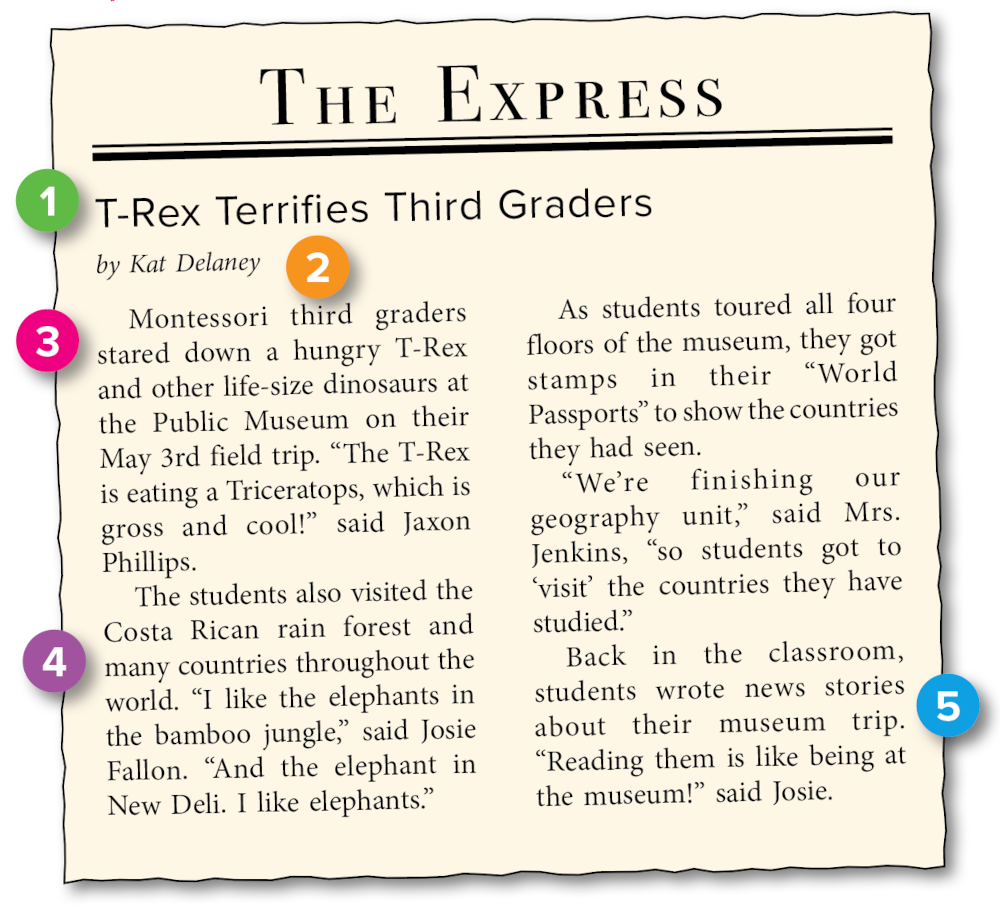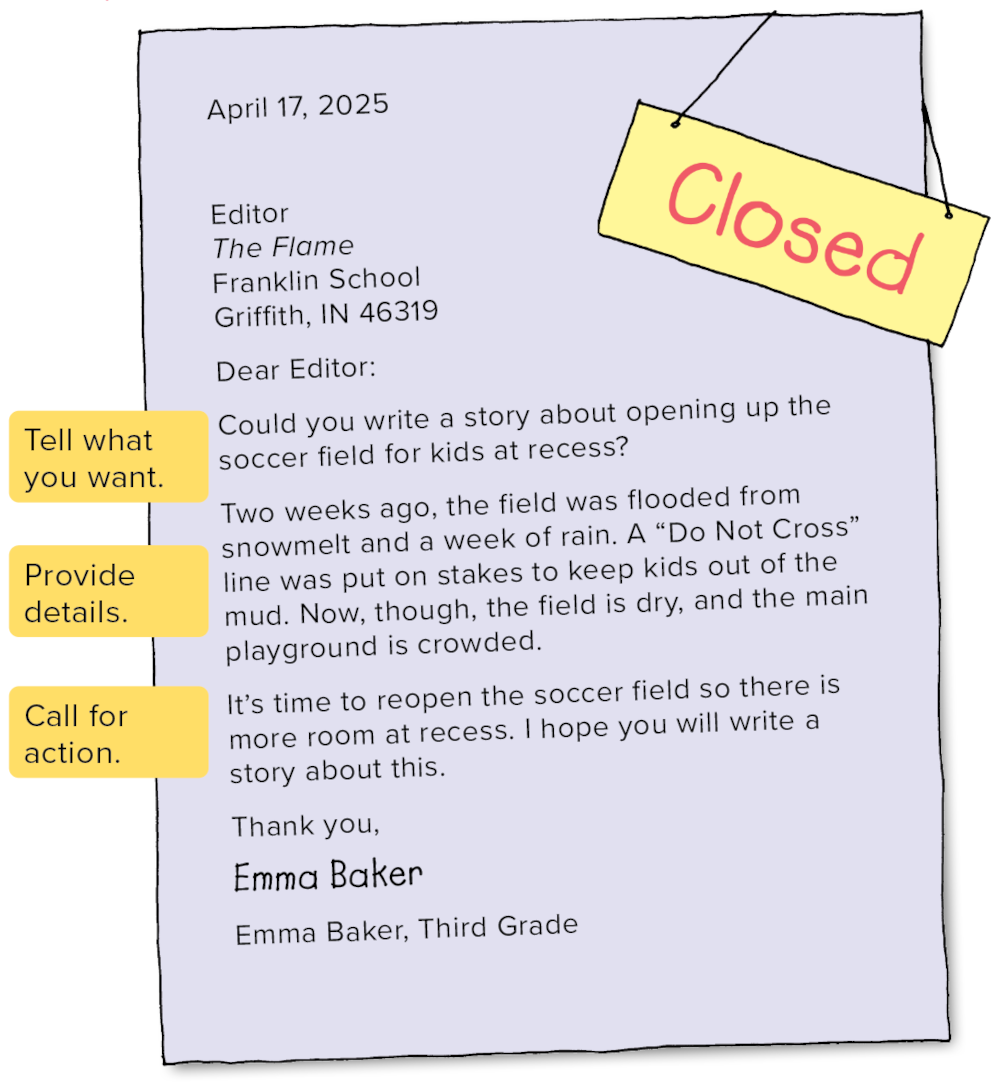WT 126
Page 126
Writing News Stories
What’s happening? The news will tell you! You can make headlines of your own by writing the news.
Write a news story to report on an important event. For example, you might tell about a field trip your class took. Or you might write a human-interest story that touches people’s hearts. One student provided tips to help others communicate with a hearing-impaired friend.
Expressing Opinions
You might even write a letter to the editor to give your opinion about an important topic. For example, you may think the soccer field should be open for recess. Expressing an opinion helps you make changes in the world!

WT 127
Page 127
Sample News Story

Parts of a News Story
1. The headline tells what the story is about.
2. The byline shows who wrote the story.
3. The lead tells readers the most important facts.
4. The body contains more information about the topic.
5. The ending gives readers something to remember.
WT 128
Page 128
Writing a News Story
Prewriting
Select a Topic 🟪 Think of important events in your school or community.
🟪 What field trips are happening?
🟪 Has your school had a special assembly?
🟪 Have there been visitors to your class?
🟪 What big projects are you working on?
🟪 What’s happening in your town?
🟪 Has your school had a special assembly?
🟪 Have there been visitors to your class?
🟪 What big projects are you working on?
🟪 What’s happening in your town?
Collect Facts 🟪 Once you have a topic, you can gather information about it using these techniques:
🟪 Observe: Go where the action is. Watch and listen. Take notes about what’s happening.
🟪 Interview: Ask people questions about your topic. Write down what they say.
🟪 Research: Look for articles about your topic and read them to understand it better.
🟪 Interview: Ask people questions about your topic. Write down what they say.
🟪 Research: Look for articles about your topic and read them to understand it better.
Tip
News stories usually answer the 5 W’s (who? what? when? where? and why?). Find answers to these questions when you collect information. (Learn more.)
WT 129
Page 129
Writing a Draft
Write the Lead 🟪 The first sentence or two in your story is called the lead. The lead should answer the reader’s basic questions.
Montessori third graders (who) stared down a hungry T-Rex and other life-size dinosaurs (what) at the Public Museum (where) on their May 3rd field trip (when).
Write the Body 🟪 The main part of your story provides the details that readers want to know about the topic.
As students toured all four floors of the museum, they got stamps in their “World Passports” to show the countries they had seen.
Write the Ending 🟪 Your ending should say something that helps readers remember the story.
Back in the classroom, students wrote news stories about their museum trip. . . .
Revising & Editing
Check Your Work 🟪 Make sure you have answered the 5 W’s in your story. Also check all facts and the spelling of names.
WT 130
Page 130
Human-Interest Story
What’s interesting? Just about anything is if you look at it carefully. A human-interest story focuses on a topic in a way that touches the heart or excites the mind.
Sample Human-Interest Story
Give Some Lip
by Ralph Kaiser
Begin with a catchy lead. Our new classmate Adele Kelly wants you to give her some lip. That’s because Adele needs to read lips to understand most conversations. She has some tips to help her new friends make lip-reading easier.
Include interesting details. 1. Get her attention before starting to talk. You might tap her shoulder.
2. Turn toward Adele. Make sure your face and lips are visible. Don’t cover your mouth.
3. Say what you will talk about. “Let’s talk about recess.” It’s easier for Adele to read your lips if she knows what the topic is.
4. Speak out loud. Adele can hear a little, so the lip reading works best with sound.
5. Signal if you change subjects. Don’t just jump to something new.
End with a fun detail. Use these tips to speak with Adele. She might even teach you a little sign language!
Give Some Lip
by Ralph Kaiser
Begin with a catchy lead. Our new classmate Adele Kelly wants you to give her some lip. That’s because Adele needs to read lips to understand most conversations. She has some tips to help her new friends make lip-reading easier.
Include interesting details. 1. Get her attention before starting to talk. You might tap her shoulder.
2. Turn toward Adele. Make sure your face and lips are visible. Don’t cover your mouth.
3. Say what you will talk about. “Let’s talk about recess.” It’s easier for Adele to read your lips if she knows what the topic is.
4. Speak out loud. Adele can hear a little, so the lip reading works best with sound.
5. Signal if you change subjects. Don’t just jump to something new.
End with a fun detail. Use these tips to speak with Adele. She might even teach you a little sign language!
WT 131
Page 131
Letter to the Editor
You don’t have to work in a newsroom to make your voice heard. Anybody can write a letter to the editor of a publication to express an opinion about any topic.
Sample Letter to the Editor
 © Thoughtful Learning 2025
© Thoughtful Learning 2025
